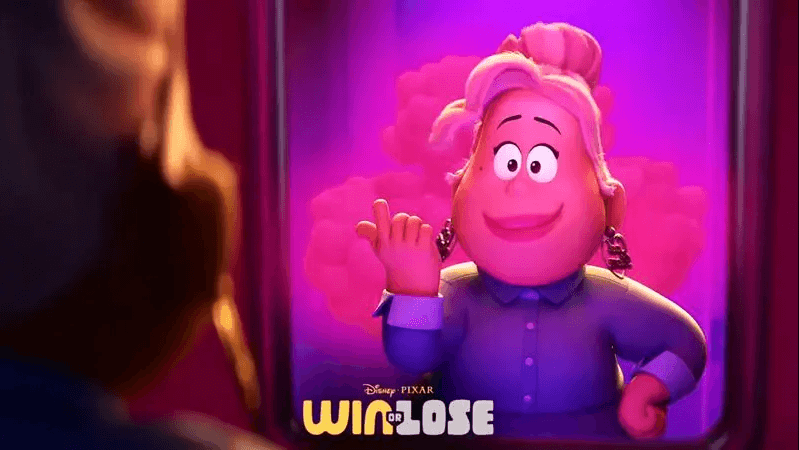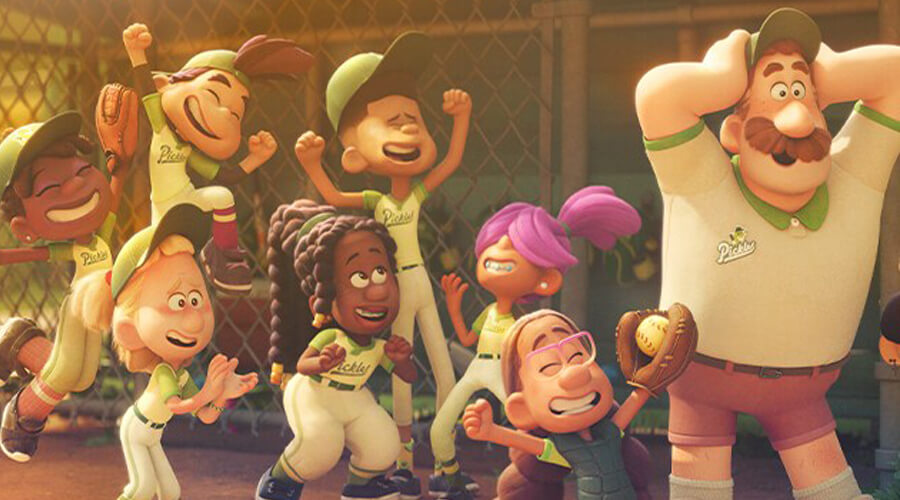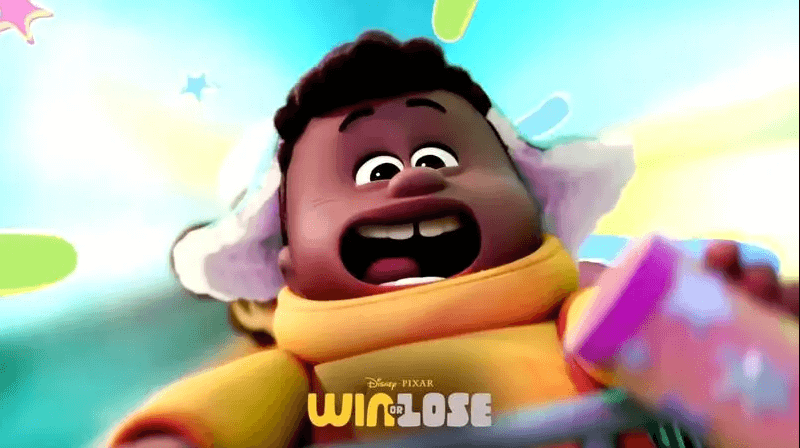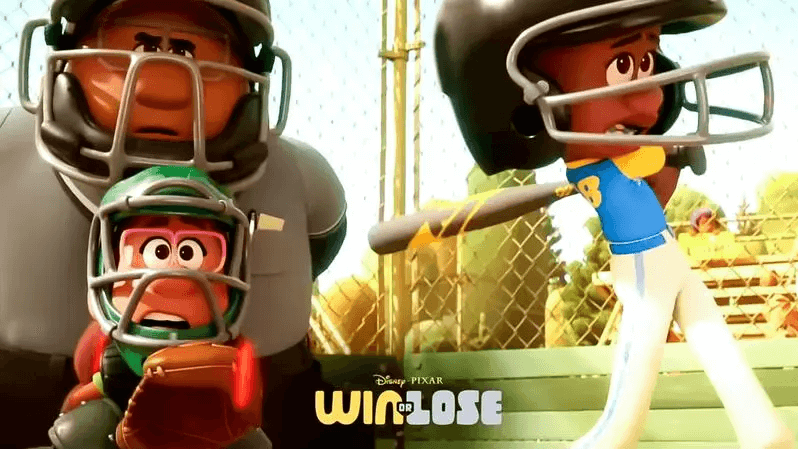Conversation with Team Behind New Pixar Series ‘Win or Lose’ | Carrie Hobson, Michael Yates, David Lally
The first full episode screening of Pixar’s Win or Lose was one of the most delightful surprises of 2023’s Annecy festival. Packaged in with the studio’s screening of their big summer blockbuster, Win or Lose felt like something of an undercard to Elemental. That tempered expectation may have been what allowed the episode to entrap the audience the way it did.

Win or Lose – Image: Pixar/Disney
Win or Lose is Pixar’s first original series and takes advantage of that format to take each episode from a different character’s perspective as the show builds up towards a middle school baseball game. In comparison to recent Pixar outings, Win or Lose is incredibly grounded with fantastical elements and magical realism taking something of a back seat.
Those elements exist in this show, but instead of being literal magical elements that exist as part of the world-building, tinges of magical realism are used to express how different characters view the world. For example, the episode screened at Annecy featured Vanessa, the mother of one of the players on the baseball team. Social media is a huge part of her life, so we see her followers literally carry her through the day in the form of a hoard of sentient ‘like’ buttons. This method of stylisation allows each episode to equip a different visual style.
Skwigly caught up with the show’s creators, Carrie Hobson and Michael Yates, as well as producer David Lally to discuss their Annecy premiere, evolving the Pixar style and telling grounded stories.
What’s been the biggest surprise from Annecy so far?
Michael Yates:
Probably just how beautiful it is. I’ve just spent a lot of time just walking around the lake, back and forth, back and forth, just watching people. And then just how much everyone is super excited about animation. I was like, ‘Oh, I should have come here much earlier.’
Carrie Hobson:
I’ve been here a few times now and I think the thing that blows me away every time is just how much brilliant animation is being made around the world. It really excites me even going and seeing how many graphic novels are being made, which we don’t necessarily get exposure to in the US. But here in France, it’s like a really huge booming thing. And you just watch so many films here. It’s non stop.
David Lally:
It’s a particularly exciting year just for the variety of feature films and styles and things like that. I can really feel the buzz around Annecy this year for all of that. But then on top of that you have a lot of the short films from graduate students, and they’re trying even wilder styles than in any of the mainstream studios. So it’s just such an amazing, exhilarating place to be inspired by.
Win or Lose seems to go beyond realism in its art style. Could you talk a bit about developing that aesthetic?
Carrie Hobson:
Yeah, I think it’s so wonderful. There’s been so many years of very realistic animation and a lot of mastery around that. But for us, specifically, what really excited us was how we can caricature life in a very authentic way, not just being cartoony for cartoony sake, but we started calling it caricatured sincerity. That bled all the way from the character design, to the design of the world, to the animation, which is really where the show thrives, because it’s a character based show. We’re really lucky at Pixar that our animators are in-house. As much as possible, they tell us ‘don’t actually talk about the technical aspects of how many in between to try to just talk about is the performance working? Do you get what I’m trying to get across?’ And I think that’s very enjoyable to live in that space, in a very caricatured manner. So it’s like, how can you express this emotion as characters feeling it in a funky way, but people feel it?
Michael Yates:
One of the things we tried to do going into each episode is we would have these hour long discussions with the animation team just about the main character. We’d show sketches, drawings from storyboards and also just talk about who they are as people, and try to find the specificity with how they move, how they would carry a cup, how they would eat, how they would drink, anything we can get to to be as specific as possible. And then once you have that groundwork for everything, when they add the fun layer to it, it is very pushed and cartoony, but it also is very specific. It goes back to that caricatured sincerity.
Carrie Hobson:
That’s such a good point that when you’re working with animators, they’re building off of each other and you’re trying to always make sure that the character feels like the same person and that it doesn’t feel like 10 different animators. That’s what I loved about our team and Gini [Cruz Santos] as one of our [animation supervisors] is that she’s helping ask us questions of like, would Vanessa do this and not this. One of our leads, Stefan Schumacher, made this moment where Vanessa walks away from her daughter and says, “Because my baby is not a cheater,” and she does this like a really pushed expression and I’m like, ‘That’s it. More of that.’
Michael Yates:
It’s something we’ve all experienced someone do but it’s usually a lot more subtle in real life. We wanted to push it to that button point where you’re like, ‘oh, yeah, I know that person.’

Win or Lose – Image: Pixar/Disney
I loved that the episode had a really fast-paced rhythm. What does the medium of TV allow you to do pacing-wise that you wouldn’t be able to do in a feature film?
Carrie Hobson:
I do really love a range of paces. Our show is very fast paced, but I do love it when I watch something like Ghibli that takes its time to sit in moments. I think we are a little bit impatient as storytellers at times.
Michael Yates:
Yeah, I would even say, I don’t know if it has to do with it being a show or feature, I think it’s just more our taste. It’s a lot of, ‘Alright, get to it, get to the information,’ and it just built off of that. If it’s shoe leather and we didn’t quite need it, we would cut it. And then it’s also about trying to find that artistic edge of the edit. What felt fresh and what you can do in editing that we usually don’t.
Carrie Hobson:
One more thing to note is in every episode, we are trying to lean into what makes that character, because each one has a different protagonist. So for Vanessa, because social media is a big part of her life, we tried to use a transition that feels like a more contemporary thing, because it just feels like Vanessa and embracing that on all levels of filmmaking.
Michael Yates:
You’ll see jump cuts that you would usually see on YouTube and things like that.
I was really happy and surprised to see 2D animation in parts of it. Could you talk about including 2D within a Pixar project?
Carrie Hobson:
There’s so many artists at Pixar who love 2D and so I don’t think that love of 2D ever went away. As soon as we said, ‘hey, this show is embracing a lot of different visualisations of people’s experience of the world and the story calls for this,’ people were just like, ‘Sign me up.’ So that was really exciting. But for example, what you saw with our character Ewan, that came from a story place. In our episode the directors brought this idea forward of the reveal that he is very insecure and fragile and just a little boy, which is what we had in the writing, they plussed it and said that that world should feel like a little stage play made by a kid made out of cardboard and they embraced that idea.
David Lally:
It’s like a CG cardboard paper craft aesthetic. In some shots it might even feel like stop motion because of the stuff that we’re going for there. But it has to get to that core idea of it being fragile. If you just blow a little piece of it you would blow it away. That’s how delicate it is. And there’s a very sensitive sweetheart inside.

Win or Lose – Image: Pixar/Disney
Were you purposely trying to subvert the Pixar house style?
Carrie Hobson:
We came at it like ‘what do we love?’ So we weren’t trying to mimic anything in particular. It was about letting the characters in the story in our own drawing style come to life and then from there working with our production designer, and our amazing team on how we can achieve more pushed expressions of these characters and do the things that we want to do with animation.
Michael Yates:
I would say the studio is very director driven in that way. Some directors just prefer that style and we came in wanting to step away from that a bit and get a little bit more caricatured. We grew up watching anime, so there’s a lot of influences there.
David Lally:
I think that’s fair and I think back to the idea of 2D. Once you introduce aesthetics that feel like stop motion or feel like 2D or more traditional CG or something that you saw inside of Vanessa’s phone which is like a digital world, it just gives us a bigger spectrum to play with to further make each of the eight characters very specific for each of those things. And so it was nice to just have such a range of styles to play with just because of the challenge of the show.
How did the show come about in the first place?
Carrie Hobson:
Pixar did show an interest in wanting ideas for a TV show. The emergence of Disney+ brought it to the forefront, although they weren’t making a mandate that they were going to make something, they were never like ‘we’ve got to do it because Disney is telling us.’ If the ideas were there, they were considering it. Mike and I were like ‘We got an idea.’ We were very hungry to make it because we love TV.
David Lally:
It’s kind of a unique storytelling structure that we haven’t really done before but you just saw how many people got really excited about that at Pixar just to try something different.

Win or Lose – Image: Pixar/Disney
Why did you want to go for a more grounded story?
Michael Yates:
I think we wanted to tell real stories, really specific stories of different people’s lives, pulling stuff from our own lives, but also our family, our friends’ lives. The whole show came from this thing of like, you can never really experience the world from someone else’s point of view. And so we took that idea and thought, ‘Okay, how do you visualise what a point of view is like? How do you visualise how someone feels about something?’ And then that kind of brought out all of these fantastical elements into the show.
You’re showing it here to the public in June, when you see the reaction from the crowd are you thinking about all the things you need to change?
Carrie Hobson:
We purposefully hung by the side just to be able to sit with people because it’s such a rare experience, especially because we made it during the pandemic. We didn’t often get to sit in a room and watch our screenings with people. And it’s so meaningful as a creator, that’s why you’re doing it, to make connections. So to hear when people are laughing means a lot, or to see if they’re squirming. I think the main thing we were just trying to pay attention to was, were there things that didn’t seem like they landed when we wanted them to? It’s really hard to know.
Michael Yates:
Or sometimes even if it was a laugh, but we think this can be a bigger laugh if we just tweaked this a little bit more.
David Lally:
Today was definitely still an in-progress version in any case, so we’ll probably do a little bit of fine tuning before you see it again.
Pixar has gone through some structural changes in the last couple years, how has that affected the day-to-day creative process?
Michael Yates:
We came in when Pete [Docter] was already at the top and he’s been there and supporting us the whole time. We really haven’t experienced anything.
David Lally:
We’ve had really consistent support at the studio. So we’ve had Pete Docter, Andrew Stanton and Lindsey Collins as our executive producers on the project and they’ve been champions from the beginning in 2019 all the way through the end. It’s been really consistent and felt nothing but support getting through it, which has been great because they’ve also been really great mentors. We’re all first timers going through this. But yeah, I think it’s been a really fun and healthy project.
Win or Lose premieres on Disney+ in December

